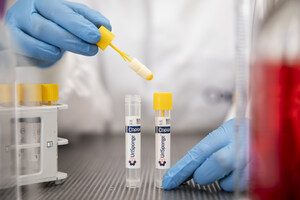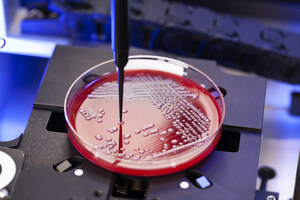Unique Multicenter Study Shows Implementation of COPAN's WASP® and WASPLab® in Various Microbiology Lab Settings is a Cost-Savings, Efficiency-Increasing Move
MURRIETA, Calif., Dec. 4, 2020 /PRNewswire/ -- Regardless of their physical size, location or specimen load, Microbiology laboratories can significantly boost their efficiencies — and subsequently cut labor costs — by replacing manual processes with full automation, according to a new study released by the Journal of Clinical Microbiology (JCM) on November 25, 2020.
The multicenter study titled "Benefits Derived from Full Laboratory Automation in Microbiology: A Tale of Four Laboratories," examined laboratories that varied in size, location, patient mix and acuity — and revealed that this automation solution benefits different types of institutions.
"Thanks to this study, we now have concrete evidence showing that labs, from large to small and from those handling a few hundred bacterial cultures a day to thousands, can all benefit by converting to a fully automated site," said COPAN Scientific Director Dr. Susan Sharp. "In the years the analyses were performed, the laboratories in this study all benefited from savings in full-time equivalents regardless of their size or their increase in specimen volume during the pre- and post-study periods."
While many studies have examined the advantages of automation, most focus on the positive effect it has on turnaround times for culture results. Instead, this novel study also looked at automation from a broader efficiency point of view, specifically measuring the benefits of automation in full-time equivalents, productivity, cost per specimen, and cost avoidance.
The pre- and post-full automation audits were performed at TriCore Reference Laboratories in Albuquerque, NM, Willis-Knighton Health System in Shreveport, LA, Hamilton Regional Laboratory Medicine Program in Ontario, Canada and Sutter Health in Livermore, CA. Even though all four of the laboratories have vastly different culture volumes, the study revealed that the implementation of full laboratory automation still had a widespread positive impact on the lab's productivity.
"This is great news for labs looking to improve their efficiencies at a time when all Microbiology labs are under the pressure of higher workloads and staffing and space constraints," said COPAN CEO Norman Sharples. "Also, the fact that it's a large, multicenter study — the first of its kind in the world — will help laboratories that may be semi-automated or completely manual, understand the significant value of automation and decide to make the leap to full laboratory automation."
Before installing full laboratory automation, researchers spent six to twelve months collecting data. After installation the WASP® and WASPLab® systems, which include smart incubators, track lines, digital culture imaging, artificial intelligence and integrated algorithm software, were evaluated against the pre-automation data. The researchers discovered the following:
- Specimen volume jumped from between 24% to 64% at every site
- Productivity increased ranging from 18% to 93%
- Total labor savings ranging from $268,000 to $1,200,000 annually, equating to a cost per specimen decrease of between 15% and 47%
COPAN's PhenoMATRIX™ software segregates positive and negative cultures, provides colony counts and screens positive from negative results obtained from chromogenic agars. WASPLab® is a modular, scalable and customizable specimen processing and culture work-up system for Clinical Microbiology. WASP® is a modular, open platform that fully automates all facets of specimen processing in Microbiology, including planting and streaking, Gram slide preparation, broth inoculation and disk application to aid in rapid, direct identification.
The researchers at TriCore Reference Laboratories and Willis-Knighton Health System also evaluated turnaround times for culture results. Before the implementation of full laboratory automation, the average turnaround time for urine culture at Willis-Knighton Health System clocked in at 30.8 hours. After converting to a fully automated facility, the Microbiology lab cut its turnaround time to 23.0 hours, resulting in a 7.8 hours faster process.
TriCore Reference Laboratories decreased their turnaround time during every step of the process. Their median turnaround time pre-automation was 35 hours, followed by 31 hours post-WASP®, 29 hours post-full laboratory automation, and 21 hours after implementation of reading algorithms. This total decrease of 14 hours was accompanied by a 24% increase in specimen volume.
With fewer individuals entering the field of laboratory medicine, Microbiologists retiring at a high rate, and most recently laboratory professionals being re-tasked to other areas of the laboratory in order to assist with increased testing demand due to COVID-19, laboratories are challenged to find a way to continue to produce quality results with fewer personnel. This study shows that fully automated laboratories can operate around the clock with fewer resources, yet still manage to release high quality results faster.
Learn more about COPAN's efficiency-boosting full laboratory automation and innovative algorithms.
About COPAN
With a reputation for innovation, COPAN is the leading manufacturer of collection and transport systems in the world. COPAN's collaborative approach to pre-analytics has resulted in Flocked Swabs, ESwab™, UTM® Universal Transport Medium, and laboratory automation, WASP® and WASPLab®. COPAN carries a range of microbial sampling products, inoculation loops, and pipettes. For more information, visit www.copanusa.com.
SOURCE COPAN Diagnostics, Inc.
Related Links
WANT YOUR COMPANY'S NEWS FEATURED ON PRNEWSWIRE.COM?
Newsrooms &
Influencers
Digital Media
Outlets
Journalists
Opted In






Share this article